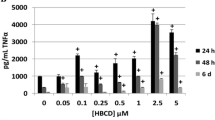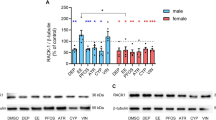Abstract
Pentachlorophenol (PCP) and Dichlorodiphenyltrichloroethane (DDT) are environmental contaminants found in human blood. Previous studies have shown that PCP and DDT inhibit the lytic function of highly purified human natural killer (NK) lymphocytes and decrease the expression of several surface proteins on NK cells. Interleukin-1 βeta (IL-1β) is a cytokine produced by lymphocytes and monocytes, and anything that elevates its levels inappropriately can lead to chronic inflammation, which among other consequences can increase tumor development and invasiveness. Here, PCP and DDT were examined for their ability to alter secretion of IL-1β from immune cell preparations of various complexity: NK cells; monocyte-depleted (MD) peripheral blood mononuclear cells (PBMCS); and PBMCs. Cells were exposed to concentrations of PCP ranging from 5 to 0.05 µM and DDT concentrations of 2.5–0.025 μM for 24, 48 h, and 6 days. Results showed that both PCP and DDT increased IL-1β secretion from all of the immune cell preparations. The specific concentrations of PCP and DDT that increased IL-1β secretion varied by donor. Immune cells from all donors showed compound-induced increases in IL-1β secretion at one or more concentration at one or more length of exposure. The mechanism of PCP stimulation of IL1-β secretion was also addressed, and it appears that the MAPKs, ERK1/2 and p38, may be utilized by PCP to stimulate secretion of IL-1β.



Similar content being viewed by others
References
Agency for Toxic Substances and Disease Registry (ATSDR) (2001) Toxicological profile for pentachlorophenol update. U.S. Department of Health and Human Services, Public Health Service, Atlanta
Balkwill F, Mantovani A (2001) Inflammation and cancer: back to Virchow? Lancet 357(9255):539–545
Beach TM, Whalen MM (2006) Effects of organochlorine pesticides on interleukin secretion from lymphocytes. Hum Exp Toxicol 25(11):651–659
Braddock M, Quinn A (2004) Targeting IL-1 in inflammatory disease: new opportunities for therapeutic intervention. Nat Rev Drug Discov 3:1–10
Brown B, Loganathan BG, Owen DA (2005) Chlorophenol concentrations in sediment and mussel tissues from selected locations in Kentucky Lake. Chrysalis 1:5–10
Centers for Disease Control and Prevention (CDC) (2003). Second national report on human exposure to environmental chemicals. Atlanta
Centers for Disease Control and Prevention (CDC) (2005) Third national report on human exposure to environmental chemicals
Chen GY, Nunez G (2010) Sterile inflammation: sensing and reacting to damage. Nat Rev/Immunol 10:826–837
Choy EHS, Panayi GS (2001) Cytokine pathways and joint inflammation in rheumatoid arthritis. N Engl J Med 344:907–916
Church LD, Cook GP, McDermott MF (2008) Primer: inflammasomes and interleukin- 1β in inflammatory disorders. Nat Clin Pract Rheumatol 4:34–42
Cirelli DP (1978) Patterns of pentachlorophenol usage in the United States of America—an overview. In: Rao KR (ed) Pentachlorophenol, chemistry, pharmacology, and environmental toxicology. Plenum Press, New York, pp 13–18
Cline RE, Hill RH, Phillips DL, Needham LL (1989) Pentachlorophenol measurements in body fluids of people in log homes and workplaces. Arch Environ Contam Toxicol 18:475–481
Cohn BA, Wolff MS, Cirillo PM, Sholtz RI (2007) DDT and breast cancer in young women: new data on the significance of age at exposure. Environ Health Perspect 115:406–414
Cooper GS, Jones S (2008) Pentachlorophenol and cancer risk: focusing the lens on specific chlorophenols and contaminants. Environ Health Perspect 116(8):1001
Coussens LM, Werb Z (2002) Inflammation and cancer. Nature 420(6917):860–867
De Sanctis JB, Blanca I, Bianco NE (1997) Secretion of cytokines by natural killer cells primed with interleukin-2 and stimulated with different lipoproteins. Immunology 90:526–533
Demers PA, Davies HW, Friesen MC, Hertzman C, Ostry A, Hershler R et al (2006) Cancer and occupational exposure to pentachlorophenol and tetrachlorophenol. Cancer Causes Control 17:749–758
Dinarello CA (1996) Biologic basis for interleukin-1 in disease. Blood 87:2095–2147
Dinarello CA (2004) Therapeutic strategies to reduce IL-1 activity in treating local and systemic inflammation. Curr Opin Pharmacol 4:378–385
Eskenazi B, Chevier J, Rosas LG, Anderson HA, Bornman MS, Bouwman H, Chen A, Cohn BA, deJager C, Henshe DS, Leipzig F, Leipzig JS, Lorenz EC, Snedeker SM, Stapleton D (2009) The pine river statement: human health consequences of DDT use. Environ Health Perspec 117:1359–1367
Franchi L, Eigenbrod T, Munoz-Planillo R, Nunez G (2009) The inflammasome: a caspase-1 activation platform regulating immune responses and disease pathogenesis. Nat Immunol 10:241–247
Gaestel M, Kotlyarov A, Kracht M (2009) Targeting innate immunity protein kinase signalling in inflammation. Nature Rev Drug Disc 8:480–499
Geisz HN, Dickhut RM, Cochran MA, Fraser WR, Ducklow HW (2008) Melting glaciers: a probable source of DDT to the Antarctic marine ecosystem. Environ Sci Technol 42:3958–3962
Hurd T, Walker J, Whalen MM (2012) Pentachlorophenol decreases tumor-cell-binding capacity and cell-surface protein expression of human natural killer cells. J Appl Toxicol 32:627–634
Hurd-Brown T, Udoji F, Martin T, Whalen MM (2013) Effects of DDT and triclosan on tumor-cell binding capacity and cell-surface protein expression of human natural killer cells. J Appl Toxicol 33:495–502
Koepke R, Warner M, Petreas M, Cabria A, Danis R, Hernandez-Avila M, Eskenazi B (2004) Serum DDT and DDE levels in pregnant women of Chiapas Mexico. Arch. Environ. Health. 59:559–565
Lewis A, Varghese S (2006) Interleukin-1 and cancer progression: the emerging role of interleukin-1 receptor antagonist as a novel therapeutic agent in cancer treatment. J Trans Med 12:1–12
Loganathan BG (2012) Global contamination trends of persistent organic chemicals: an overview. In: Loganathan BG, Lam PKS (eds) Global contamination trends of persistent organic chemicals. CRC Press, Boca Raton, pp 3–31
Lopez-Castejon G, Brough D (2011) Understanding the mechanism of IL-1b secretion. Cytokine Growth Factor Rev 22:189–195
Lucas K, Hohlfeld R (1995) Different aspects of cytokines in the immunopathology of multiple sclerosis. Neurology 45:S4–S5
Madureira P, de Mello RA (2014) BRAF and MEK gene rearrangements in melanoma: implications for targeted therapy. Mol Diagn Ther 18:285–291
Martinon F, Tschopp J (2007) Inflammatory caspases and inflammasomes: master switches of inflammation. Cell Death Differ 14:10–22
Meyer TP, Zehnter I, Hofmann B, Zaisserer J, Burkhart J, Rapp S, Weinauer F, Schmitz J, Iller WE (2005) Filter buffy coats (FBC): a source of peripheral blood leukocytes. J Immunol Meth 307:150–166
Nnodu U, Whalen MM (2008) Pentachlorophenol decreases ATP levels in human natural killer cells. J Appl Toxicol 28:1016–1020
Numerof RP, Kotik AN, Dinarello CA, Mier JW (1990) Pro-interleukin-1 beta production by a subpopulation of human T cells, but not NK cells, in response to interleukin-2. Cell Immunol 130:118–128
Patterson DG Jr, Wong LY, Turner WE, Caudill SP, Dipietro ES, McClure PC, Cash TP, Osterloh JD, Pirkle JL, Sampson EJ, Needham LL (2009) Levels in the U. S. population of those persistent organic pollutants (2203-2004) included in the Stockholm Convention or in other long-range trans-boundary air pollution agreements. Environ Sci Technol 43:1211–1218
Reed A, Dzon L, Loganathan BG, Whalen MM (2004) Immunomodulation of human natural killer cell cytotoxic function by organochlorine pesticides. Hum Exp Toxicol 23:463–471
Sahoo M, Ceballos-Olvera I, del Barrio L, Re F (2011) Role of the inflammasome, IL-1β, and IL-18 in bacterial infections. Sci World J 11:2037–2050
Shi C, Pamer EG (2011) Monocyte recruitment during infection and inflammation. Nat Rev Immunol 11:762–774
Smith HA, Kang Y (2013) The metastasis-promoting roles of tumor-associated immune cells. J Mol Med 91:411–429
Snedeker SM, Stapleton D (2009) The pine river statement: human health consequences of DDT use. Environ Health Perspec 117:1359–1367
Svensson BG, Hallberg T, Nilsson A, Schütz A, Hagmar L (1994) Parameters of immunological competence in subjects with high consumption of fish contaminated with persistent organochlorine compounds. Int Arch Occup Environ Health 65:351–358
Swaan P, Knoell D, Helsper F, Wewers M (2001) Sequential processing of human ProIL-1β by caspase-1 and subsequent folding determined by a combined in vitro and in silico approach. Pharm Res 18:1083–1090
Thornton JW, McCally M, Houlihan J (2002) Biomonitoring of industrial pollutants: health and policy implications of the chemical body burden. Public Health Rep 117:315–323
Trejo-Acevedo A, Diaz-Barriga F, Carrizales L, Dominguez G, Costilla R, Ize-Lema I, Yarto-Ramirez M, Gavilan-Garcia A, Mejia-Saavedra JJ, Perez-Maldonado IN (2009) Exposure assessment of persistent organic pollutants and metals in Mexican children. Chemosphere 74:974–980
Turusov V, Rakitsky V, Tomatis L (2002) Dichlorodiphenyltrichloroethane (DDT): ubiquity, persistence, and risks. Environ Health Perspect Rev 110:125–128
Udoji F, Martin T, Etherton R, Whalen MM (2010) Immunosuppressive effects of triclosan, nonylphenol, and DDT on human natural killer cells in vitro. J Immunotoxicol 7:205–212
Uhl S, Schmid P, Schlatter C (1986) Pharmacokinetics of pentachlorophenol in man. Arch Toxicol 58:182–186
Wang YJ, Ho YS, Jeng JH, Su HJ, Lee CC (2000) Different cell death mechanisms and gene expression in human cells induced by pentachlorophenol and its major metabolite, tetrachlorohydroquinone. Chem Biol Interact 128:173–188
Acknowledgments
Grant U54CA163066 from the National Institutes of Health.
Author information
Authors and Affiliations
Corresponding author
Rights and permissions
About this article
Cite this article
Martin, T.J., Whalen, M.M. Exposures to the environmental toxicants pentachlorophenol (PCP) and dichlorodiphenyltrichloroethane (DDT) modify secretion of interleukin 1-beta (IL-1β) from human immune cells. Arch Toxicol 91, 1795–1808 (2017). https://doi.org/10.1007/s00204-016-1829-1
Received:
Accepted:
Published:
Issue Date:
DOI: https://doi.org/10.1007/s00204-016-1829-1




